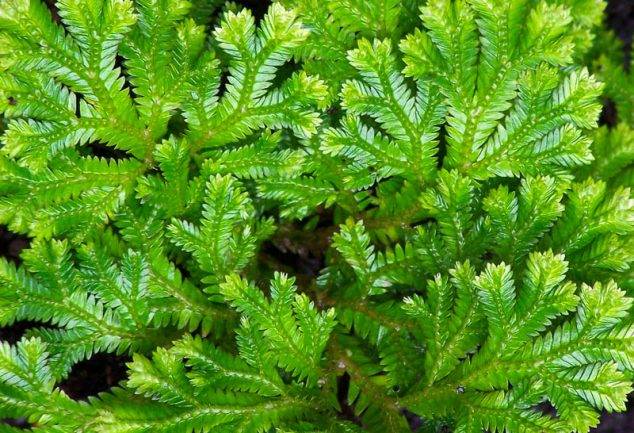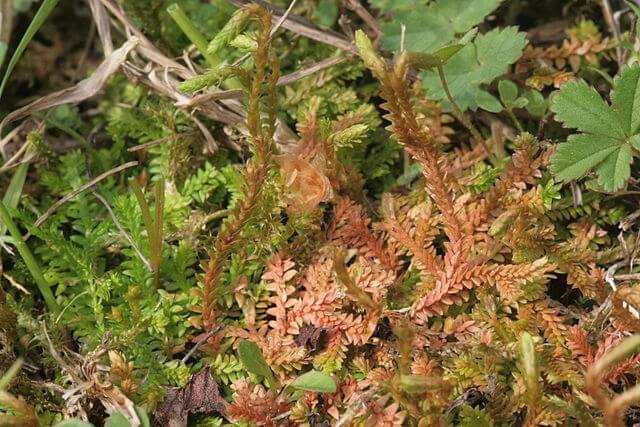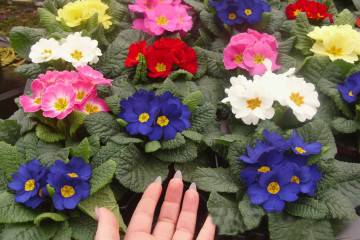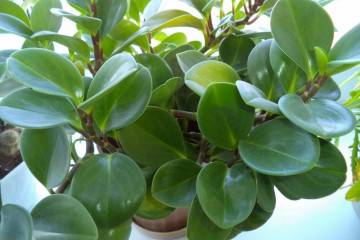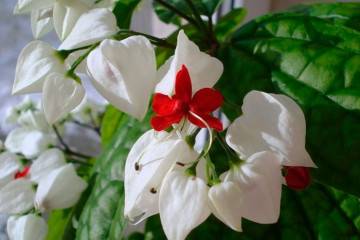Selaginella scaly: home care and main types
Content:
The strange but extremely decorative selaginella flower is not often found in homes. Even less often, it can be found as a decoration in landscaping. And completely in vain. Reminiscent of either a coniferous plant, or a succulent, or a fern, the plant is able to add an unusual flavor of the primordial prehistoric era to the atmosphere of a house or garden.
Common types
Selaginella is a plant numbering more than 300 species and belongs to the Plaunkov family. Distributed in the humid tropics of Central Africa and South America. The size of the plant, depending on the conditions of existence and the species, can be from 10 cm. up to 2-3m.
Scale-leaved
Selaginella Lepidophylla is perhaps the most amazing representative of ground cover plants. His homeland is not very suitable for life, the Mexican Chihuahua Desert. It would seem that unbearable heat and scorching winds can kill all living things. But not scaly selaginella.
But everything changes literally before our eyes, if a favorable environment is created for the plant. In a matter of minutes, the flower will spread its seemingly lifeless dried twigs and change color from brown to green. For this property to resurrect in the Middle East, where the flower is especially common, it was named the Jericho rose. However, the open flower bears little resemblance to the queen of flowers.
Martens
Selaginella Martensii is the most famous and commonly cultivated species. Usually the height of an adult plant does not exceed 25-30 cm. Dense light green leaves with white edging create the effect of bizarre patterns. Selaginella Martens is characterized by rapid growth and the need for abundant watering and good lighting.
Krauss
Selaginella Kraussa looks great in hanging planters, because it has stems that are long enough for poultry. Usually their length is 30-32 cm. This species can have leaves of yellow-green and white-green colors. The plant produces specific outgrowths that increase the hiding power of the plant, giving it a special density.
Apoda
Selaginella Apoda, or pegged selaginella, is a miniature bush that does not exceed 20 cm in height. The stems of the plant are covered with small, frequent leaves. The hiding power of this plant is such that some people mistake it for moss.
Jory
Selaginella Jori is a spherical shrub that is formed by erect stems. The height of such a ball rarely exceeds 20 cm. Small exotic-shaped leaves are similar to scallops, they form a dense green foam.
Swiss
Selaginella Swiss is found on the rocky slopes of Europe, the North Caucasus, rocky hills of the Far East. It differs from other species by the abundance of thin twigs with light green leaves located at an angle of 90 ° relative to the stem.Swiss Selaginella prefers care in the form of high humidity and constant partial shade.
Selaginella, rose of jericho: planting and care
Despite the fact that in nature Selaginella is able to survive in the harshest conditions, in an apartment or house a plant can quickly die from lack of attention from the grower. Thus, selaginella will respond to home care with lush and active growth.
First of all, you need to take a responsible approach to the choice of location. Despite the fact that the flower's habitat is hot deserts, the plant is unlikely to survive in direct sunlight, inhabiting the window of the southern location. Thus, it is better to place the flower pot on the west or east side, where diffused light predominates.
Planting soil
To plant this plant, you need a light, neutral or slightly acidic soil that can hold moisture well. A soil mixture consisting of turf, river sand, sphagnum and peat will ideally meet these requirements. When laying soil in a pot, do not forget about drainage. Its quantity should be at least half the volume of the container.
Temperature regime
The most comfortable temperature for Selaginella is 18-20 ° C. Minor short-term fluctuations will not cause any significant harm to the plant. But if you neglect the care of the flower, then this can affect its decorative effect. The maximum allowable temperature drop is 12 ° C.
Watering mode
All types of selaginella are moisture-loving plants. However, they will not tolerate excessive moisture or waterlogging of the soil. Watering is carried out exclusively with settled water as the topsoil dries up. At the same time, the water temperature should not be too low.
Top dressing and loosening
The splendor and healthy appearance of the plant is ensured by year-round feeding. In the spring-summer period, you need to fertilize the flower once a month, and, from autumn to the end of winter, it is enough to apply fertilizing once every 60 days. Fertilizers are chosen for either orchid species or deciduous plants.
To ensure air permeability of the soil, the top layer is regularly loosened.
Reproduction
Under natural conditions, Selaginella reproduces by spores. For reproduction at home, this method is not used due to the complexity of this process. Usually the plant is propagated by dividing the bush and grafting.
Reproduction by dividing the bush
The division of the bush for the purpose of reproduction is usually carried out in the spring during a planned transplant. The root system of the plant is divided into several small parts and planted in individual containers filled with peat. From above, the plant is covered with a special cap to create a greenhouse effect. From time to time it is recommended to ventilate the miniature greenhouse and monitor the soil moisture.
Propagation by cuttings
Selaginella, the rose of Jericho, can reproduce successfully by cuttings. To do this, a shoot 7-9 cm long is taken from an adult healthy plant. Before planting selaginella, you should dry the cut area a little or treat it with root. Planting is carried out in individual pots and covered with a cap. Daily airing and regular spraying will benefit the young seedling.
Diseases and pests
As a rule, Selaginella is not susceptible to disease and is quite resistant to pest attacks.However, if the soil dries up and the humidity drops, insects can attack the plant, which spread in a dry microclimate. These include aphids, scale insects, spider mites. In this case, insecticides should be applied at least twice with an interval of 14 days.
If you overdo it in watering, then over time, the root system of the plant can be affected by root rot. In this case, you need to adjust the soil moisture regime, and in extreme cases, transplant the plant into a new soil, after drying and treating the roots with an antifungal solution.
Thus, selaginella is an unusual indoor flower. Caring for him requires care and regularity. If all needs are met, then the plant will delight with its appearance for a long time.
